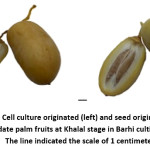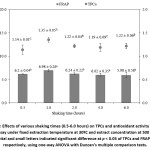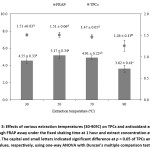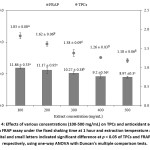Introduction
Date palm (Phoenix dactylifera L.) is a largely agricultural plant in the Middle East and North Africa with more than 1,500 varieties.1 The development of date palm fruit can be divided into 5 stages, including Hanabeuk, Kimri, Khalal, Rutab and Tamr stages.2 During fruit development, the color changes from green to yellow or red, depending on the varieties.2 In general, the last three stages namely Khalal, Rutab and Tamr stages are commonly consumed because of softer texture and sweeter flavor. The fruits in Tamr stage are consumed in a form of dry fruits; however, fresh date palm fruit in Khalal stage is currently of interest. The previous study stated that Khalal stage of Barhi cultivar, which is recently economical crop growing in Eastern Thailand, is currently consumed in the form of fresh fruit.2 Besides, date palm fruit in this stage is a good source of nutritive values referred from the proximate composition study, in which it contained 222 kcal energy, 1.8 g protein, 0.2 g fat, 56.9 g carbohydrate, and 39.7% moisture content per 100 g.1 Interestingly, previous study also suggested that the fruit in Khalal stage exhibited higher total phenolic content and antioxidant activity analyzed by FRAP assay than the ones in Rutab and Tamr stages.3-4 In term of health properties, date palm fruit was reported to contain high phenolic contents with antioxidant activities, which can fight against various toxicants.5 Moreover, in vitro study stated that date palm fruit extract inhibited human breast adenocarcinoma progression and exhibited the properties against leukemia and microbial activities.6
Current studies from Thailand on the effect of Khalal stage of date palm cultivar variation on TPCs and antioxidant activities is sparse. Normally, date palm is populated using cell culture technique to sustainably maintain the genetics of exact cultivar. However, this technique required high preparation cost and is time consuming. Thus, reproducing date palm using seed can reduce cost and is a custom propagation to increase date palm population. However, seed originated date palm might possess variation in genetics due to natural selection, possibly in attempt to self-adapt to the environment. Besides, proper extraction conditions for further development of food product from the fruit at this stage is missing.
Therefore, this study aimed to investigate the water based extraction conditions, such as extraction temperatures, shaking time and solid-to-liquid ratio of date palm fruit at Khalal stage in Barhi cultivar (collected in Thailand in 2019) to establish the proper extraction protocols regarding bioactive compounds and antioxidant activities. Under optimized extraction conditions, TPCs and antioxidant activities of date palm fruit from different cultivar originates, like cell culture originated (CO) and seed originated (SO), were compared to examine the effect of cultivar variation.
Materials and Methods
Sample Preparation
Cell culture originated (CO) and seed originated (SO) date palm fruits at Khalal stage in Barhi cultivar were supplied by T.A.P. Chon Buri Co., Phanat Nikhom district, Chon Buri province, Thailand. SO was received from date palms growing from seeds of cell cultured date palms. The samples were collected during July-August, 2019. The samples were cleaned with deionized water (DI) before separating flesh and seed. The colors of fresh samples were analyzes using a ColorFlex EZ spectrophotometer from Hunter Associates Laboratory (Virginia, USA) and expressed in the Hunter-Lab units, including L* (darkness to lightness), a* (green to red) and b* (blue to yellow). Clean samples were cut into 0.3 cm thick before freeze-drying using a Heto powerdry PL9000 freeze dryer (Heto Lab Equipment, Allerod, Denmark) for 3 days. Dry samples were ground into fine powder using a grinder (Philips 600W series from Philips Electronic Co., Ltd., Jakarta, Indonesia). The powdery samples were packed into vacuum aluminum foil bag and kept at -20°C until further analysis.
Optimization of Extraction
Optimization of extraction conditions were performed under three parameters, including shaking times, extraction temperatures and concentrations of sample, according to the report by Sripum et al., 20167. Briefly, CO powder was mixed with distilled water before incubating in a temperature-controlled water bath shaker (WNE45 series from Memmert GmBh, Wisconsin, USA) for a particular shaking time period (0.5, 1, 2, 4 and 6 hours). The mixture was then centrifuged at 3,800xg using a Hettich® ROTINA 38R refrigerated centrifuge (Andreas Hettich GmbH, Tuttlingen, Germany) for 15 minutes. The supernatant was filtered through a 0.45 µM PES membrane syringe filter before keeping at -20°C for further analyses.
To investigate the shaking time, the sample at the concentration of 500 mg/mL were extracted at 30ºC and shaking for 0.5, 1, 2, 4 and 6 hours. Likewise, extraction temperatures were optimized by varying extraction temperatures at 30, 50, 70, 90°C, while fixing the sample concentration at 500 mg/mL and shaking for 1 hour. Lastly, the optimized sample concentrations were examined by varying the sample concentrations to 100, 200, 300, 400 and 500 mg/mL, while fixing the traction temperature at 50°C and shaking for 1 hour. The optimized extraction conditions were determined through TPCs and FRAP activity as indicated below.
Total Phenolic Contents (TPCs) Assay
TPCs were determined according to Ainsworth and Gillespie, 20078 and Sripum et al., 2016.7 The extract (25 μL) was mixed with 10% (v/v) Folin–Ciocalteu’s phenol reagent (50 μL) and 7.5% (w/v) sodium carbonate (200 μL). The mixture was then incubated at 25°C for 2 hours in dark. TPCs were monitored at a wavelength of 765 nm using a SynergyTM HT 96-well UV-visible microplate reader from BioTek Instruments, Inc. (Vermont, USA) with Gen 5 data analysis software. Gallic acid (0-200 μg/mL) was used as a standard.
Ferric Reducing Antioxidant Power (FRAP) Assay
FRAP assay was performed according to Benzie and Strain, 19969 and Sripum et al., 20167. The extract (20 μL) was incubated at 25ºC for 8 minutes in dark with FRAP reagent (150 μL), which was prior prepared by mixing 300 mM acetate buffer pH 3.6, 10 mM TPTZ solution in 40 mM HCl, 20 mM ferric chloride hexahydrate (FeCl3•6H2O) solution in the ratio of 10:1:1, respectively. The FRAP activity was monitored at a wavelength of 600 nm using the microplate reader. Trolox (0–250 µM) was used as a standard.
1,1–Diphenyl–2–picryl hydrazyl (DPPH) radical scavenging assay
DPPH radical scavenging assay was performed according to Fukumoto and Mazza, 200010 and Sripum et al., 2016.7 The sample extract (22 µL) was mixed with 135 µM DPPH reagent in 95% (v/v) aqueous ethanol (200 µL). The mixture was incubated at room temperature for 30 minutes in dark. The reaction was monitored at a wavelength of 520 nm using the 96-well microplate reader. The free radical scavenging activity was calculated using the following equation;
![]()
where ΔA is a different absorbance between blank and sample, I is an intercept of standard curve, S is a slope of standard curve, F is a dilution factor, fv is a final volume of solvent extract (mL), DW is a dry weight of sample (g DW) and 1000 is a conversion from L to mL. Trolox (10-640 µM) was used as a standard.
Oxygen radical antioxidant capacity (ORAC) assay
The ORAC assay was determined according to Huang et al., 200211 and Sripum et al., 2016.7 In brief, the extract (25 µL) was mixed with 30 nM fluorescein solution (150 µL) before incubating at 37°C for 30 minutes in dark. To the mixture, 153 mM 2,2′–azobis (2–amidinopropane) dihydrochloride (25 mL) was added, and the fluorescence intensity was measured for 90 minutes using the microplate reader at the excitation wavelength of 485 nm and the emission wavelength of 528 nm. The antioxidant activity was calculated by the difference in area under sodium fluorescein decay curve (AUC) using the following equation;
AUC = (0.5 + f1 / f0 + f2 / f0 + f3 / f0 + …. + (0.5) fi / f0) ´ CT,
where f0 is the initial fluorescence reading at 0 minute, fi is the fluorescence reading at i minutes, and CT is the cycle time in minutes. Trolox (0-100 µM) was used as a standard.
Results and Discussion
Characteristics of date palm fruit
It was found that the overall size of SO was smaller than CO (Fig. 1). The average size of CO was 3.73±0.12 cm in height, 2.11±0.09 cm in width and 0.67±0.24 cm in thickness, while SO possessed 3.13±0.28 cm in height, 2.00±0.90 cm in width and 0.54±0.10 cm in thickness. The results of color measurement expressing as Hunter-Lab units (L*, a* and b*) suggested that both CO and SO possessed the dark reddish yellow color of exocarb (outer skin), while mesocarb (inner flesh) had lighter color (Table 1). The mesocarp of CO and SO had similar color, but the exocarp of SO was yellower than that of CO.
 |
Figure 1: Cell culture originated (left) and seed originated (right) date palm fruits at Khalal stage in Barhi cultivar. The line indicated the scale of 1 centimeter. Click here to View figure |
Table 1: Color values of cell culture originated (CO) and seed originated (SO) date palm fruits at Khalal stage in Barhi cultivar
|
Date palm fruit |
Color values in Hunter-Lab units | |||
| L* | a* | b* | ||
| CO | Exocarp | 48.10±1.39 | 12.21±0.57 | 37.28±0.08 |
| Mesocarp | 65.72±2.99 | 3.21±0.79 | 20.85±1.93 | |
| SO | Exocarp | 48.26±4.89 | 11.80±0.92 | 46.61±2.65 |
| Mesocarp | 65.77±1.35 | 3.87±0.78 | 21.02±2.05 | |
All data were expressed as mean ± standard deviation (SD) of triplicate experiments.
Effects of Extraction Time
The result indicated that by fixing the extract concentration at 500 mg/mL and extraction temperature at 30°C, the shaking time at 1 hour exhibited the highest TPCs (1.35 mg GAE/g DW) and FRAP activity (6.98 µmol TE/g DW) (Fig. 2). Similarly to the previous study of Lapornik et al., 200512 in the comparison of extraction time and bioactive compound of red currant (Ribes rubrum var. Rondom), it was found that 1 hour for extraction provided the highest content of phenolics and antioxidant activity. After increasing the shaking time, phenolics and antioxidant activity were decreased. It was previously suggested by Fick’s second law of diffusion that a final equilibrium can be achieved at a certain time when the solute concentrations in the solid matrix and in the bulk solution are equal.13 Thus, after the equilibrium is reached, increase in time cannot increase released phenolics. Instead, prolonged incubating time might cause a degradation of phenolics.14 Thus, in our experiment, an equilibrium time was reached at 1 hour, while longer shaking time from 2-6 hours caused a reduction in TPCs and FRAP activities (Fig. 2).
 |
Figure 2: Effects of various shaking times (0.5-6.0 hours) on TPCs and antioxidant activity through FRAP assay under fixed extraction temperature at 30ºC and extract concentration at 500 mg/mL. The capital and small letters indicated significant difference at p < 0.05 of TPCs and FRAP values, respectively, using one-way ANOVA with Duncan’s multiple comparison tests. Click here to View figure |
Effect of extraction temperature
Under the fixed shaking time at 1 hour and extract concentration at 500 mg/mL, no significant difference in TPCs of the samples extracted under 30-70°C was observed (approx. 1.5 mg GAE/g DW), while TPC was decreased significantly at 90ºC (Fig. 3). Antioxidant activity determined by FRAP assay was potentially the highest when extracting at 50ºC (5.17 µmol TE/g DW) (Fig. 3). Therefore, the most suitable extraction temperature for date palm fruit was 50°C. Corresponding with this study, the previous studies reported that extraction temperature of Henna (Lawsonia inermis) at 55ºC provided the greatest TPCs15, and peach (Prunus persica L.) extracted at 50-60ºC was found to exhibit the highest antioxidant activity via FRAP assay.16 The temperature affects bioactive compounds by softening the tissue of plant cell wall and stimulates the phenol-protein and phenol-polysaccharide to diffuse into the solvent.17 However, heating might induce phenolic compound degradation as well.17. Supported by the study of Le et al., 2005 stating that after increasing the temperature from 19 to 65ºC for extraction of citrus peels, FRAP activities were reduced by half.15 Therefore, the increase the extraction temperature with prolonged period of time can affect the activity of antioxidant activity.
 |
Figure 3: Effects of various extraction temperatures (30-90ºC) on TPCs and antioxidant activity through FRAP assay under the fixed shaking time at 1 hour and extract concentration at 500 mg/mL. The capital and small letters indicated significant difference at p < 0.05 of TPCs and FRAP values, respectively, using one-way ANOVA with Duncan’s multiple comparison tests. Click here to View figure |
Effect of Sample Concentrations
By fixing shaking time at 1 hour and extraction temperature at 50°C, date palm fruit extracted at 100 mg/mL provided the highest TPC (1.8 mg GAE/g DW), while increased extract concentrations (200-500 mg/mL) continuingly lowered TPCs (Fig. 4). Likewise, date palm fruit extracted at 100 and 200 mg/mL provided the highest FRAP activities (approx. 12 µmol TE/g DW). However, increasing extract concentrations from 300 to 500 mg/mL caused a decrease in FRAP activities. According to the previous study on the effect of solid-to-liquid ratio (12.5-100 mg/mL) of citrus peel, it was found that the lowest extract concentration at 12.5 mg/mL provided the highest TPCs.18 Likewise, black mulberry leaves extracted under the concentration of 0.033 mg/mL exhibited the higher TPCs than the one extracted at 0.1 mg/mL. The solid-to-liquid ratio was previously reported to be consistent with the mass transfer principle.19 The driving force during mass transfer is consistent with the concentration between the solid and liquid solvent.13-14,20 Low solid-to-liquid ratio can increase surface interactions between solid and solvent, resulting in more driving force for bioactive compounds to penetrate through cell walls into solvent.
 |
Figure 4: Effects of various concentrations (100-500 mg/mL) on TPCs and antioxidant activity through FRAP assay under the fixed shaking time at 1 hour and extraction temperature at 50°C. The capital and small letters indicated significant difference at p < 0.05 of TPCs and FRAP values, respectively, using one-way ANOVA with Duncan’s multiple comparison tests. Click here to View figure |
TPCs and FRAP activities of CO and SO samples
Under the optimized extraction conditions (100 mg/mL extract, 1 hour of shaking time and 50°C of extraction temperature), the difference in TPCs (determined by Folin Ciocalteau’s reagent) and antioxidant activities through FRAP, ORAC and DPPH scavenging activity assays of CO and SO were investigated. The results suggested that SO exhibited significantly higher TPCs and antioxidant
activities determined by FRAP and ORAC assays than CO (Table 2). However, CO exhibited higher antioxidant activity determined by DPPH radical scavenging assay than SO.
Table 2: Total phenolic contents (TPCs) and antioxidant activities of date palm fruit in Barhi cultivar with cell culture originated (CO) and seed originated (SO) methods
| Originates | TPCs (mg GAE/g DW) |
Antioxidant activities | ||
| FRAP assay (µmol TE/g DW) |
DPPH radical scavenging assay (µmol TE/100 g DW) |
ORAC assay (µmol TE/g DW) |
||
| CO | 3.47±0.33b | 16.13±0.81b | 0.25±0.02a | 123.21±9.77b |
| SO | 3.87±0.23a | 19.23±0.80a | 0.21±0.01b | 185.68±9.29a |
The small letters indicated significantly difference between cultivar methods using independent t-test at p < 0.05.
Two functions of antioxidants, hydrogen atom transfer (HAT) and single electron transfer (SET) mechanisms are proposed.21-22 The HAT reaction is based on a transfer of hydrogen atom (H•) of antioxidant to free radical, while SET reaction involves the donation of one electron to electron acceptor. In our experiments, TPCs were correlated with FRAP (SET mechanism) and ORAC (HAT mechanism) assays, suggesting that phenolics from date palm fruits can function as both SET and HAT antioxidants. However, DPPH radical scavenging (HAT and SET mechanisms) activity was in the opposite trend. It is possible that this method is less sensitive than FRAP and ORAC assays; therefore, small change in DPPH radical scavenging activity can lead to misinterpreted results. Besides, DPPH radical scavenging assay is more suitable for measuring antioxidant activity in hydrophobic system.23 The in vitro investigation on Chaetoceros didymus extract suggested that increased TPCs could be achieved with increased polarity index of solvent extraction, while the highest DPPH radical scavenging activity was observed with the sample extracted under non-polar solvent.24
Comparing to previous literature using the sample at the same stage (Khalal stage) and cultivar (Barhi), it was found that TPCs detected in our experiment were higher than those reported in the ethanolic and acetone extracts (2.15 and 3.16 µmol GAE/g fresh weight, respectively).25 Moreover, the TPCs detected in our experiment were higher than the ones from date palm fruits at Khalal stage but in different cultivars (Khalas and Sequh cultivars with the TPCs of 0.03 and 0.05 mg GAE/g DW, respectively).26 Date palm fruit at Khalal stage in Tunisian and Ahmar cultivars, however, exhibited the similar TPCs (3.0-8.5 mg GAE/g DW) as the ones in our experiments.27 Nevertheless, the different TPCs might be a result of altered extraction conditions and plant varieties.
Conclusion
Date palm fruit at Khalal stage in Barhi cultivar is generally consumed as fresh fruit. The optimized extraction conditions were achieved at 100 mg/mL extract concentration, 1 hour of shaking time and 50°C of extraction temperature. Under these conditions, seed originated date palm fruits exhibited potentially higher TPCs and antioxidant activities than cell culture originated samples. This study has demonstrated the nutritional benefit of this fruit due to its antioxidant properties. It is equally important to encourage the growth of the plant due to its enormous economic benefit.
Conflict of Interest
The authors declare no conflict of interest.
Acknowledgments
The authors would like to express gratitude to T.A.P. Chon Buri Co., Phanat Nikhom district, Chon Buri province, Thailand, for providing the date palm fruit. We also would like to thank Miss Varittha Sritalahareuthai and Mr. Werawat Wannasaksri for insight suggestions of manuscript preparation.
References
- Al-Farsi A. M., Lee Y. C. Nutritional and Functional Properties of Dates: a Review. Crit Rev Food Sci Nutr. 2008; 48(10): 877-887.
- Ghnimi S., Umer S., Karim A., Kamal-Edin A. Date Fruit (Phoenix dactylifera L.): an Underutilized Food Seeking Industrial Valorization. Nutr Food Sci. 2017; 6: 1-10.
- Haider S. M., Khan A. I., Jaskani J. M., Naqvi A. S., Khan M. M. Biochemical Attributes of Dates at Three Maturation Stages. Emir J Food Agr. 2014; 26(11): 953-962.
- Amira A. E., Guido F., Behija E. S., Manel I., Nesrine Z., Ali F., et al. Chemical and Aroma Volatile Compositions of Date Palm (Phoenix dactylifera L.) Fruits at Three Maturation Stages. Food Chem. 2011; 127(4): 1744-1754.
- EI-Far H. A., Oyinloye E. B., Sepehrimanesh M., Allah G. A. M., Abu-Reidh I., Shaheen M. H., et al. Novel Findings and Future Directions for Food and Drug Discovery. Curr Drug Discov Technol. 2019; 16(1):2-10.
- Jaouni A. K. S., Alghamdi N., Hossary E. D., Harakeh S. Effects of Phoenix dactylifera Ajwa on Infection, Hospitalization, and Survival Among Pediatric Cancer Patients in a University Hospital: A Nonrandomized Controlled Trial. Integr Cancer Ther. 2019; 18(1): 1-9
- Sripum C., Kukreja R. K., Charoenkiatkul S., Kriengsinyos W., Suttisansanee U. The Effect of Storage Conditions on Antioxidant Activities and Total Phenolic Contents of Parboiled Germinated Brown Rice (Khao Dok Mali 105). Int Food Res J. 2016; 23(4): 1827-1831.
- Ainsworth E. A., Gillespie, K. M. Estimation of Total Phenolic Content and Other Oxidation Substrates in Plant Tissues using Folin–Ciocalteu reagent. Nat. 2007; 2(4): 875-877.
- Benzie F. F. I., Strin J. J. I. The Ferric Reducing Ability of Plasma (FRAP) as a Measure of Antioxidant Power: the FRAP Assay. Anal Biochem.1996; 239(1): 70-76.
- Fukumoto L. R., Mazza G. Assessing Antioxidant and Prooxidant Activities of Phenolic Compounds. J Agric Food Chem. 2000; 48(8): 3597-3604.
- Huang D., Ou B., Hampsch-Woodill M., Flanagan, A. J., Prior L. R. High-Throughput Assay of Oxygen Radical Absorbance Capacity (ORAC) Using a Multichannel Liquid Handling System Coupled with a Microplate Fluorescence Reader in 96-Well. J Agric Food Chem. 2002; 50(16): 4437-4444.
- Lapornik B. M., Prošek M., Wondra G. A. Comparison of Extracts Prepared From Plant By-Products Using Different Solvents and Extraction Time. J Food Eng. 2005; 71(2): 214-222.
- Silva M. E., Rogez H., Larondelle Y. Optimization of Extraction of Phenolics from Inga Edulis Leaves Using Response Surface Methodology. Sep Purif Technol. 2007; 55(3): 381-387.
- Salar R. K., Purewal S. S., Bhatti M. S., Optimization of Extraction Conditions and Enhancement of Phenolic Content and Antioxidant Activity of Pearl Millet Fermented with Aspergillus Awamori MTCC-548. Reffit. 2016; 2(3): 148-157.
- Tan M. C., Tan C. P., Ho C. W. Effects of Extraction Solvent System, Time and Temperature on Total Phenolic Content of Henna (Lawsonia inermis) Stems. Int Food Res. 2013; 20(6): 3117-3123.
- Mokrani A., Madani K. Effect of Solvent, Time and Temperature on The Extraction of Phenolic Compounds and Antioxidant Capacity of Peach (Prunus persica L.) Fruit. Sep Purif Technol. 2016; 162(1): 68-76.
- Bey M. B., Louaileche H., Zemouri S. Optimization of Phenolic Compound Recovery and Antioxidant Activity of Light and Dark Dried Fig (Ficus carica L.) Varieties. Food Sci Biotechnol. 2013; 22(6): 1613-1619.
- Xu G., Ye X., Chen J., Liu D. Effect of Heat Treatment on the Phenolic Compounds and Antioxidant Capacity of Citrus Peel Extract. J Agric Food Chem. 2007; 55(2): 330-335.
- Radojković M., Zeković Z., Jokić S., Vidović S., Lepojević Ž., Milošević S. Optimization of Solid-Liquid Extraction of Antioxidants from Black Mulberry Leaves by Response Surface Methodology. Food Technol. 2012; 50(2): 167-176.
- Cacace E. J., Mazza G. Mass Transfer Process during Extraction of Phenolic Compounds From Milled Berries. J Food Eng. 2003; 59(4): 379-389.
- Apak R., Özyürek M., Güçlü K., Çapanoğlu E. Antioxidant Activity/Capacity Measurement. 2. Hydrogen Atom Transfer (HAT)-Based, Mixed-Mode (Electron Transfer (ET)/HAT), and Lipid Peroxidation Assays. J Agric Food Chem. 2016; 64(5): 1028-1045.
- Choi H., Yang K., Lee S. G., Lee J. P., Koo I. S. Single Electron Transfer (SET) Pathway: Nucleophilic Substitution Reaction of 4-Chloro-7-Nitrobenzofurazan with Anilines in MeOH-MeCN Mixtures. B Korean Chem Soc. 2010; 31(10): 2801-2805.
- Floegel A., Kim D. O., Chung S. J., Koo S. I., Chun O. K. Comparison of ABTS/DPPH Assays to Measure Antioxidant Capacity in Popular Antioxidant-Rich US Foods. J Food Compos Anal. 2011; 24(7): 1043-1048.
- Noreen H., Semmar N., Farman M., McCullagh J. S. Measurement of Total Phenolic Content and Antioxidant Activity of Aerial Parts of Medicinal Plant Coronopus didymus. Asian Pac J Trop Biomed. 2017; 10(8): 792-801.
- Borochov-Neori H., Judeinstein S., Greenberg A., Volkova N., Rosenblat M., Aviram, M. Date (Phoenix dactylifera L.) Fruit Soluble Phenolics Composition and Anti-Atherogenic Properties in Nine Israeli Varieties. J Agric Food Chem. 2013; 61(18): 4278-4286.
- Ali H., Al-Khalifa A. R., Farouk A., Shaheen M. Effect of Maturation Stages on Flavor Profile and Antioxidant Activity of Date Palm Fruits (Phoenix dactylifera) Grown in Saudi Arabia. Int J Pharmaco, 2018; 14(3): 407-414.
- Lemine F. M. M., Ahmed M. V. O. M., Maoulainine L. B. M., Bouna Z. E. A. O., Samb A., Boukhary A. O. M. S. O. Antioxidant Activity of Various Mauritanian Date Palm (Phoenix dactylifera L.) Fruits at Two Edible Ripening Stages. Food Sci Nutr. 2014; 2(6): 700-705.

This work is licensed under a Creative Commons Attribution 4.0 International License.





